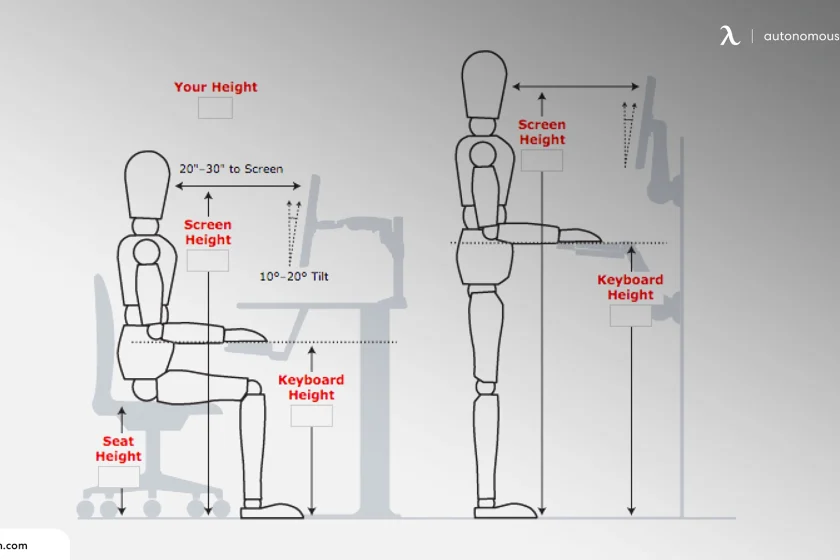Contents
Choosing the right table height is crucial for comfort and ergonomics, whether you’re setting up a dining room, a workspace, or a casual gathering area. The height of a table can significantly impact your posture, comfort level, and even your productivity during meals or work sessions.
Many people overlook the importance of table height, often leading to discomfort, fatigue, and even long-term health issues. Investing time in measuring and understanding your ideal table height can make a world of difference in your daily life.
In this article, we’ll dive into the practical steps to measure table height for comfort and ensure that your space is as functional as it is stylish.
Finding the perfect table height isn’t just about aesthetics; it involves understanding your body’s needs and the activities you’ll be performing. This comprehensive guide will help you assess the right table height for various settings, ensuring that your space promotes comfort and productivity.
Why Measuring Table Height Matters
Properly measuring table height contributes to overall comfort and health. Incorrect table heights can lead to poor posture, increased fatigue, and discomfort during activities such as dining or working. Here are some key aspects of why measuring table height is essential.
Posture – Supporting Healthy Alignment
Proper table height plays a significant role in supporting a healthy posture. If your table is too high or too low, you might find yourself slouching or straining your back, neck, and shoulders. This can lead to chronic pain and discomfort over time.
For dining tables, aim for a height between 28 to 30 inches, which is generally comfortable for most adults. Forming an L-shape with your arms and elbows when sitting can help determine if the table height is appropriate. Your forearms should rest comfortably on the table without raising your shoulders.
Functionality – Enhancing Usability
The right table height enhances the usability of your space. Whether it’s a dining, coffee, or work table, each serves a different purpose and requires different height considerations. Tables that are too tall or too short can hinder your ability to perform tasks effectively.
For work desks, the ideal height typically ranges from 28 to 30 inches as well, but it can depend on other factors, such as your chair height. Consider using an adjustable chair to help find the perfect height for both chair and desk. This will improve your overall workspace ergonomics, making you more productive.
How to Measure Table Height
Measuring table height accurately is crucial to ensure comfort. Follow these steps to determine the optimal height for your specific needs.
Using a Measuring Tape
The simplest way to measure table height is by using a measuring tape. Start by placing one end of the tape measure on the floor directly beneath the table leg. Extend the tape measure vertically to the underside of the tabletop.
Record the height in inches to determine if it’s suitable for your needs. For added accuracy, measure from multiple points on the table to account for any unevenness in the surface.
Consider Your Seating
Your table height should complement the seating arrangements you have. Measure the height of your chairs or stools from the floor to the seat. A good rule of thumb is that there should be about 10-12 inches of space between the seat and the table for comfortable legroom.
To ensure comfort when seated, sit in the chair you plan to use and check if your knees can fit comfortably under the table. This will help prevent any awkward positioning that can lead to discomfort.
Test Different Heights
If possible, try out different table heights before making a final decision. You can do this by using blocks or stacks of books to elevate a table temporarily. Sit at different heights to see what feels most comfortable.
Engage friends or family in this process, as different body types may have different preferences. Getting feedback from others can help you make a more informed choice.
Safety Considerations When Choosing Table Height
While measuring for comfort, it’s essential to consider safety aspects, especially in homes with children or elderly members.
When selecting a table height, consider the presence of sharp edges and corners. Tables that are too low may cause individuals to bump their heads or knees, while those that are too high could be precarious for young children.
Opt for tables with rounded edges or protective covers if there are concerns about safety. Especially in households with children, this can prevent injuries during daily activities.
Stability and Weight Distribution
Ensure that the table is stable and can support the weight of items you plan to place on it. A table that is too tall may become unstable if overloaded with items, leading to safety hazards.
Check the table’s stability by applying gentle pressure on the tabletop. It should not wobble or feel unsteady, regardless of its height. This will ensure that it serves you well without posing safety risks.
In conclusion, measuring table height for comfort is essential for enhancing your overall well-being, productivity, and safety. By understanding the importance of posture, functionality, and safety, you can ensure that your table meets your specific needs. Follow the outlined steps for measuring, consider your seating, and test different heights to find the right fit for your lifestyle. By taking the time to measure accurately, you can enjoy a more comfortable and functional space that aligns with your daily activities and promotes healthy habits.

